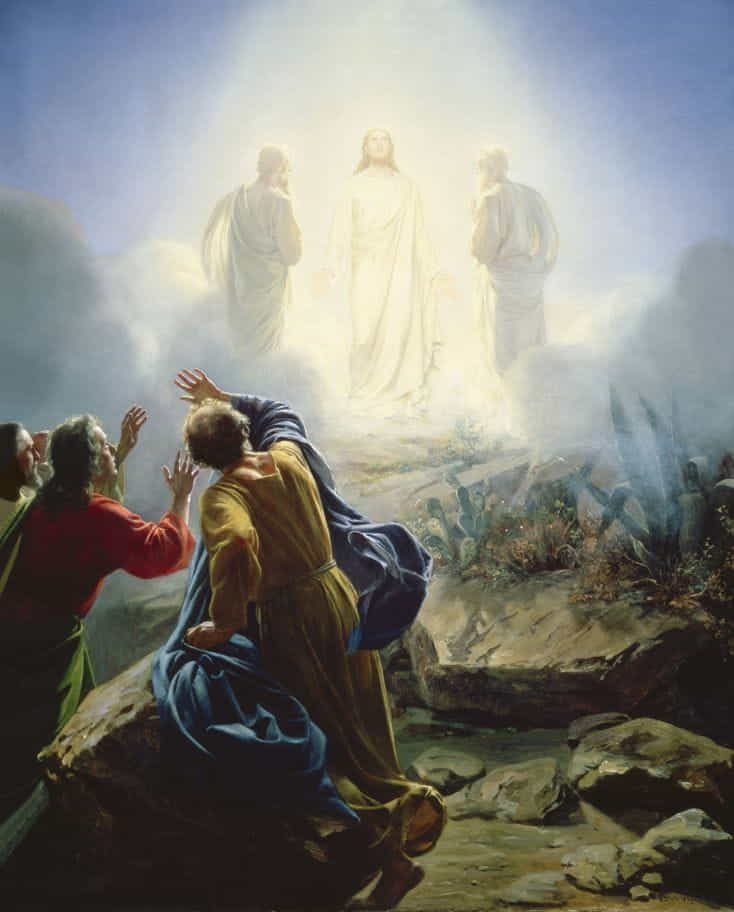Today (August 6th/August 19th) is the Transfiguration of the Lord, in the Twelve Great Feasts. The Feast of the Transfiguration, popularly called “the Apple Feast Day,” has great significance for the very structure of Orthodox time. It is not just the end of summer; it is the ultimate spiritual dimension of what can be called the harvest.
Just as the pure and sacred work of the peasantry—the sunny, regal labor of tilling the land and caring for domestic animals—gives its concrete visible fruit each year in the form of grain, milk, wine, eggs, meat, and apples, so too must the spiritual life of the Christian be crowned with the highest possible contemplation—the contemplation of the Transfiguration of Christ on the Holy Mount, Tabor. Visions of the immaterial Light of Tabor, in which the Lord transfigured Himself before His chosen disciples, is the pinnacle of the spiritual journey of the Christian, the highest of gifts, the end of the journey—strictly upwards, to the Son of God, the Light.
The theological meaning of the feast is connected with the moment of the meeting of the two Covenants, the Old and the New. Christ and His three apostolic disciples, Peter, James, and John, ascended the mountain. While the disciples slept, Christ addressed a prayer to God the Father and this chosen place was flooded with Eternal Light. When the disciples awoke, they were startled and awe-struck to see their teacher, Jesus, conversing in the Divine Light with the two elders, Moses and Elijah the prophet. If Jesus Christ had been a prophet, He would have proved His prophetic dignity by this encounter. And this is exactly what the terrified disciples thought: let us, they said, set up three sanctuaries here, a sanctuary for each of the prophets.
They were apparently right in the logic of the Old Testament: the higher righteous ones met on the other side of life and death in the Light of Truth. But this was not the case. Jesus Christ is not a prophet nor a continuator of the Jewish tradition. He is much, much more than that. He is God and the Son of God. And the Light in which He spoke to the righteous of the Old Testament was not ordinary—but Divine—the one that shone then, when there was nothing at all—neither light nor darkness. And He, the Light of Tabor, was already there. And when the world is gone, it will still shine. And that the apostles, who will build the Church of the New Testament, the Church of the Son of God, the Church of the Holy Trinity and the Uncreated Light of Tabor, would have no doubt, a Voice was heard from heaven: “This is My beloved Son, in whom I am well pleased.” Thus, on Mount Tabor the highest Christian truth was unveiled—the truth about the Son, about God the Word.
One of the participants in this universal mystery, the Apostle John, will write in his Gospel, “In the beginning was the Word.” He learned what the Word was and what the beloved Son of God was at this very moment on the Holy Mount, Tabor. The New Testament recognizes and honors the righteous and the prophets of the Old Testament. But Jesus Christ is not one of them. He is our True God—and this is what distinguishes our Christian age of Grace from the former Jewish era of the Law.
On Mount Tabor, at the moment of Transfiguration, this was revealed to the three Apostles, and through them to the rest of mankind. The Athonite monks and Russian elders believed that to see the Light of Tabor was the goal of the entirety of Christian life. The vision of the Light of Tabor begins the monastic life of the Russian saint Sophronius Sakharov, who, after this gift, went straight from modern, comfortable Paris directly to the wild cave of Athos. After all, there is nothing more precious and higher than contemplating eternity. But in order to see this Light, the Hesychast starets taught, one must put his mind into his heart and cleanse his heart from the darkness of matter, of sins and of all the ugliness with which our heart is most often filled. For as the Elder Sophronius said, “The true way to see the Divine Light is through the inner man.” Until we discover and cultivate the inner man, until we examine and purify our essence, we will remain in darkness. After all, everything that is not the Light of Tabor is, by and large, one continuous, impenetrable darkness.
Today the words of Simeon the New Theologian, quoted by the elder Sophronius Sakharov, are most appropriate: “Come, Light of Truth. Come, eternal life. Come, the rising of the fallen. Come, the rising of the deposed. Come, the resurrection of the dead… Come, O holy King, Come and dwell in us, and abide in us without ceasing, And reign undivided in us—The One for ever and ever. Amen.”
Alexander Dugin is a widely-known and influential Russian philosopher. His most famous work is The Fourth Political Theory (a book banned by major book retailers), in which he proposes a new polity, one that transcends liberal democracy, Marxism and fascism. He has also introduced and developed the idea of Eurasianism, rooted in traditionalism. This article appears through the kind courtesy of Geoolitica.
Featured: “Transfiguration of Jesus,” by Carl Bloch; painted in 1872.
